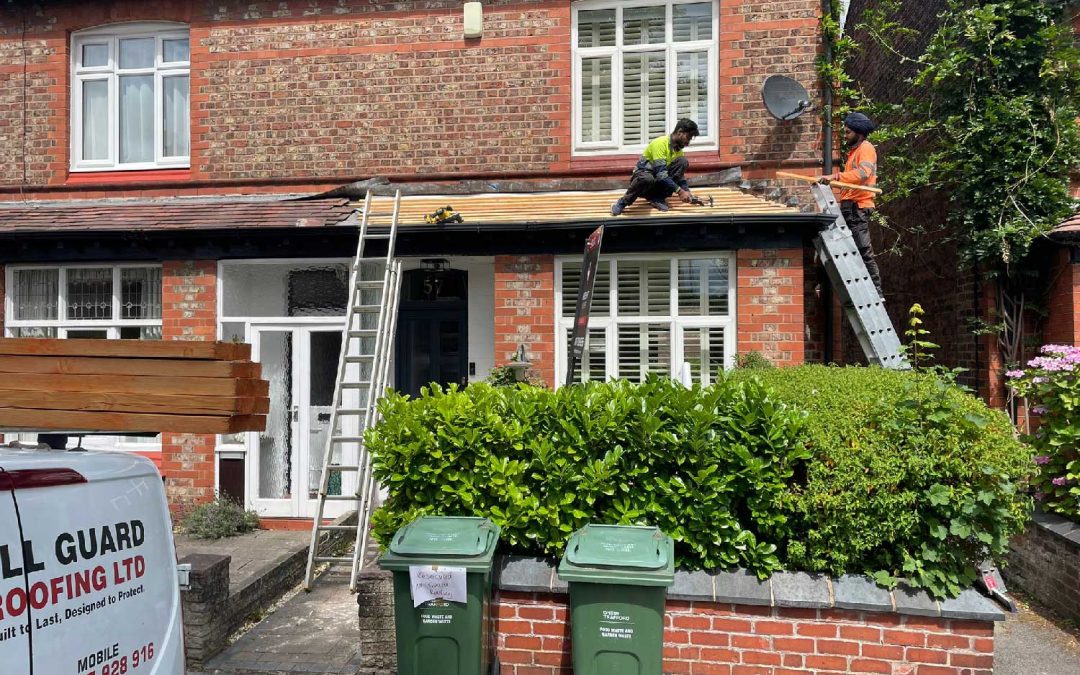So, your roof’s sprung a leak and you’re in Manchester? Yeah, that sucks. Nothing like a bit of British weather to remind you your house isn’t quite as waterproof as you thought. But freaking out won’t fix it — here’s what you actually need to do (and roughly what it’ll cost you).
Step 1: Don’t Play Spiderman
If it’s blowing a gale or chucking it down, stay off the roof. Honestly, just don’t. You don’t need a trip to A&E on top of a leaking ceiling.
If water’s dripping near sockets or lights, kill the electrics in that part of the house. Then grab a few buckets, move your valuables out of harm’s way, and take some photos or videos of the damage.
You’ll want that evidence for insurance later — and who knows, maybe your soggy ceiling TikTok will go viral.
Step 2: Call in the Pros
Next, it’s time to call an emergency roofer in Manchester. The good news? There are plenty of solid roofers who do 24/7 callouts, especially during storm season when half the city’s losing slates.
When you ring around, give them the basics:
- What type of roof you’ve got (tile, slate, flat, felt, etc.)
- What you can see (missing tiles, leaks, sagging bits, flashing flapping about)
- Whether it looks unsafe or in danger of collapsing
This helps them work out whether they’re bringing a ladder, a tarp, or the full toolbox. A good roofer will talk you through what’s urgent, what’s not, and how quickly they can get there.
Step 3: The Real Talk — Emergency Roofers Manchester Cost
Alright, let’s talk money — because that’s the bit everyone really wants to know.
Here’s a rough guide to emergency roofer costs in Manchester, so you know what’s fair and what’s daylight robbery:
| Type of Job | Average Cost (excl. VAT) | What’s Included |
| Emergency call-out fee | £100 – £250 | Usually covers first hour of labour |
| Quick patch or tile fix | £150 – £400 | Minor leaks or tile replacement |
| Full tile replacement | £400 – £800+ | Depends on roof type and access |
| Flat roof repair | £200 – £500 | For felt, rubber, or asphalt roofs |
| Tarp / temporary cover | £100 – £200 | To stop leaks during bad weather |
| Scaffolding (if needed) | £300 – £800 | Adds stability and safety |
If someone’s quoting triple these prices without explaining why — run a mile. Or better yet, tell them you’ll “get back to them” and hang up.
Tip: Always get a quote in writing or at least a solid verbal estimate before they arrive. Some cowboys see the word “emergency” and decide to retire off your misfortune.
Step 4: How Fast Will They Get There?
Response times depend on how wild Manchester’s weather’s being that day.
- 1 hour or less: If it’s a serious leak or falling debris
- 2–4 hours: Most out-of-hours emergencies
- Same day: Non-critical repairs (minor drips, slipped tiles)
During storms, expect delays — every roofer in Greater Manchester will be swamped. Booking early or having a trusted local number saved in your phone can really help.
Step 5: Expect a Temporary Fix First
In most emergency callouts, the roofer will focus on stopping the leak, not rebuilding the whole roof there and then.
They might:
- Fit a tarp or temporary sheet
- Apply sealant or flashing tape
- Replace a few dislodged tiles
Once the weather clears, they’ll schedule a follow-up visit for permanent repairs.
Ask them to document what they’ve done — photos, receipts, even a written note. If you’re claiming on insurance, this will make life a lot easier.
Step 6: Dealing with Insurance
Here’s where things can get tricky, so stay sharp. Most UK home insurance policies cover sudden roof damage from storms, wind, or falling trees. But they’ll draw the line at “wear and tear” or “lack of maintenance.”
Here’s what to look for in your paperwork:
- Storm or Emergency Repair cover — check you’re actually insured for it.
- Excess amount — usually between £100–£300.
- Approved contractors — some insurers make you call their roofer, not your own.
- Evidence requirements — photos, invoices, and written reports help a lot.
If your roof’s older than your nan’s Ford Fiesta, or you’ve ignored cracked tiles for years, don’t expect much sympathy from your insurer. Preventable damage rarely gets a payout.
Step 7: Stop It Happening Again
Once you’ve patched things up, make a plan to stay ahead of future leaks:
- Book a roof inspection every year, especially after winter.
- Clean gutters and downpipes — blocked ones cause overflow leaks.
- Replace cracked or slipped tiles early.
- Trim trees near your house so branches can’t smash tiles in a storm.
Think of it like a car MOT — a bit of regular care costs less than a roadside breakdown. Preventative maintenance can save you hundreds (and a lot of stress).
Step 8: Keep Calm, Stay Dry, and Be Smart
Roofing emergencies always happen at the worst possible time — late at night, during a storm, or just after payday when your wallet’s already empty.
But if you remember a few key things, you’ll be alright:
- Stay safe — no DIY heroics.
- Call a local Manchester roofer you can trust.
- Know your costs — don’t get scammed.
- Sort your insurance before the next storm rolls in.
The next time you’re Googling “emergency roofers Manchester cost” with rain dripping through the light fitting, you’ll know exactly what to do — and what not to fall for.
Good luck, mate. Stay dry.

